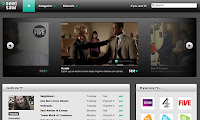It struck me, as often it does, that there are patterns of behaviour which taken together might point towards shifts in the relationship between audience and institution, between the producer/user and the content aggregator and distributor. The traditional lines of production and reception are blurring and evolving - maybe that's why we're seeing a prevalence of stories expressing concern, confusion and outrage.
Let's begin with the study. A Home Office report, led by Dr Linda Papadopoulos, claimed this week that children were being mentally affected by viewing an excess of sexually explicit material in the media. Amongst other recommendation the report suggests having parental blocks switched on as the default on mobile phones, computers and games consoles. It also suggests putting an age limit for so called Lads' mags.
The report claims there's a clear link between youngster viewing sexually explicit material and the rise of violence towards females. There's a host of other recommendations and it'll be interesting to see if an incoming Conservative government, or re-elected Labour administration, is bold enough to tackle head-on the challenge of web data access, in order to protect the young.
Of course, claiming that the young of today are worse behaved than previous generations is nothing new. Take this quotation for example:
'The Children now love luxury; they have bad manner, contempt for authority; they show disrespect for their elders and love chatter in place of exercise. Children are now tyrants, not the servants of their households. They no longer rise when elders enter the room. They contradict their parents, chatter before company, gobble up food at the table, cross their legs, and terrorize their teachers.'
That was Socrates, two thousand years ago, and so it's possible to see how critics on both sides of the argument might claim either that the Greeks' theory of moral decline is merely accelerating, thanks to the Web et al; or conversely, that since each generation thinks subsequent ones are worse behaved than it was, there's little to worry about.
However, other developments in the last seven days point to something more pernicious creeping into the zeitgeist. Three Google executives received six-month suspended sentences in Italy, following the uploading in that country to YouTube of footage showing an autistic boy being bullied. This raises fundamental questions about whether the Web is a free domain for content exchange, or a place that should be monitored and filtered at source. Trying to 'police' and censor content is likely to prove an impossible task, given the sheer scales of economy the Web creates. But the Italian case does raise questions about responsibility and accountability. We might be living in an age of unfettered access to content of every hue, but can legislation restore a sense of morality and balance into the lives of the young? This is where parents and teachers face the mounting challenge of modelling good online behaviour, and using dialogue with common sense to help young people make the right decisions for themselves.
Equally terrifying and so wrong on every level, was news that an American school had deployed laptops to students, then used the integrated webcams to spy on students. This included allegedly watching them undress and other private activities. Although the education authority is claiming the activation was used only to locate lost laptops, the fact this remote access wasn't detailed in the contracts signed by parents shows a disregard for ways in which technology can be abused; or at least, seen to be abused. Currently there is one lawsuit pending, in which a male student was allegedly seen acting 'improperly' at home - the evidence was a screen grab from his school laptop's webcam. In this case, the breach of trust between educational institution and student points to a wider issue about digital identity, safety and representation. Although this may seem an extreme case, nonetheless it highlights the dangers in using technology to enhance the learning experience positively.
And so, to end with something uplifting. I found this fantastic video of American childrens' TV host, Mister Rogers. I came across the following blog post by Karl Staib, in which he talks about the importance of trust in business relationships. His role model of the caring interlocutor is Mister Rogers, who in 1969 managed to persuade a Congressional hearing, looking to cut public spending on educational TV programming, to have a change of heart. Listening to Mister Rogers' submission is a reminder of the need for passion, honesty and clearly communicated core values; if the lives of children are to be enriched, happy, creative and fruitful.
The vide clip lasts just under seven minutes.
Do make time to watch it.










